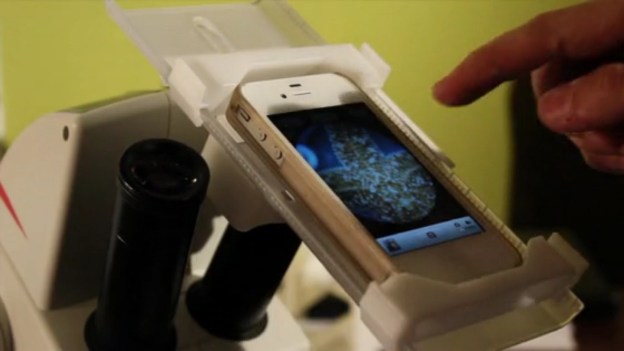 A smartphone accessory named SkyLight, aims to be a low-cost bridge between old and new technology. SkyLight is an adapter for smartphones that supposedly connects to any microscope, and gives the scientific device a digital upgrade using the phone’s camera. The project is currently pursuing funding through Kickstarter.
A smartphone accessory named SkyLight, aims to be a low-cost bridge between old and new technology. SkyLight is an adapter for smartphones that supposedly connects to any microscope, and gives the scientific device a digital upgrade using the phone’s camera. The project is currently pursuing funding through Kickstarter.
The SkyLight team consist of Oakland-based engineerAndy and Geologist Tess. Andy came up with the concept for SkyLight while working on a low-cost microscope for countries in need. He decided that, not only was technology scarce in developing countries but so was availability to trained healthcare workers. A noble sentiment shared we’ve seen shared by UC Davis’ Sebastian Wachsmann-Hogiu and his ball lens tweak for the iPhone.
However, the SkyLight team points out the singularity of their idea, saying the device “is the first of its kind, as there is no other available device that attaches any smarthpone to any microscope.”

The adapter is light, weighing 4.9 ounces, and is made of various plastics. The SkyLight claims it will snuggle onto any eyepiece between 1.00” and 1.75” and lock in place. The smarthpone, fitted between the adapter’s two clips, is in charge of fine focus using its autofocus. Once calibrated, the smartphone camera can capture photos as well as video which can then be uploaded to the web, or viewed via video-conference software.
The team gave an example of the benefit of this device to, say, health workers in Malawi, Africa using old microscopes from the 80s, who could send send diagnostic images to a doctor hundreds of miles away. Andy says he even used the adapter with a 1960s microscope being used in Costa Rica. The device could also be beneficial in classrooms as a refreshing digital makeover for old government funded microscopes.
The Skylight Kickstarter page is aiming for $15,000 by January 2 of next year, and they have more $11,000 so far. The adapter can be owned starting at a pledge of $60, and for every five SkyLight devices sold one will be donated for global health or education.


